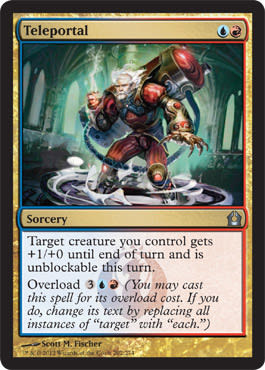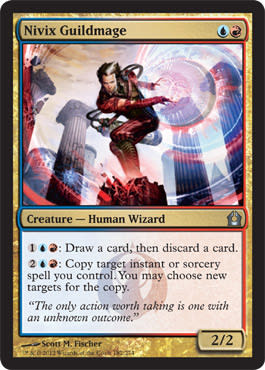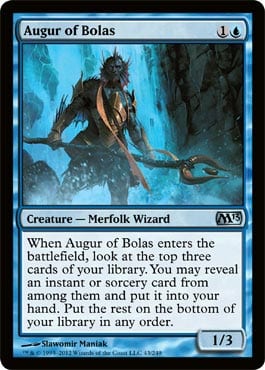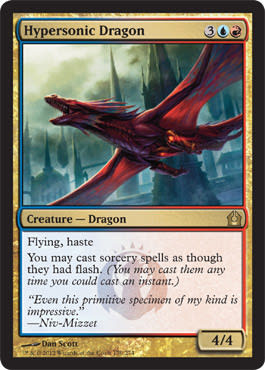There are many ways to attain a flash of wild scientific inspiration. While actually earning an advanced degree, working in a lab, and applying for grants may work for some, others might have just as much luck strapping a metal colander crammed with gizmos and flashing things to their heads. As it happens, we'll happily settle for a much more restrained approach: cracking open the box of the Return to Ravnica Intro Pack, Izzet Ingenuity. While the results are expected to be just as zany and unpredictable, chances are good that you'll find fewer people worried about tearing holes in the space-time continuum doing it the Wizards way rather than smashing atoms together in some underground European bunker.
Esteemed colleagues and fans of experimental science, we hope you've been enjoying Izzet Theme Week here on GatheringMagic and on the mothership. As you might have guessed by the title, this also means that we'll be breaking down Izzet Ingenuity and rebuilding it, purely in the name of science. Of course, we'll be doing this all through the rigors of the Izzet's well-honed scientific method:
- Hypothesis (OPTIONAL)
- Observation of conditions (OPTIONAL)
- Control of variables (OPTIONAL)
- Experimentation
- Observation of outcome (if still alive)
As in previous entries, we'll be keeping to the customary restrictions of the Meddling series. These are designed to keep the resultant deck both inexpensive and easy to obtain. First, there will be no added rares or mythics—only commons or uncommons can be used to reinforce the card pool, though of course, we do start off with the rares provided by the Intro Pack. Second, we'll only be drawing upon cards from sets already represented in Izzet Ingenuity; namely, Return to Ravnica and Magic 2013.
Hypothesis and Observations of Conditions
Izzet Ingenuity has a two distinct paths to victory, both of which overlap and intertwine with something that's not quite synergy but reasonably approximates it. The two prongs of this strategy are as follows:
A. Bulk up on creatures, then get them past your opponent's defenses either by sneaking them past (Teleportal) or forcing them through (Mizzium Mortars, Blustersquall).
B. Application of direct damage, either through burn (Explosive Impact and friends) or indirectly through the Guttersnipe
Here's the stock decklist:
"Intro Pack: Izzet Ingenuity"
- Creatures (16)
- 1 Hypersonic Dragon
- 1 Nivix Guildmage
- 1 Tenement Crasher
- 1 Welkin Tern
- 2 Blistercoil Weird
- 2 Goblin Electromancer
- 2 Guttersnipe
- 3 Cobblebrute
- 3 Runewing
- Spells (19)
- 1 Blustersquall
- 1 Chandra's Fury
- 1 Downsize
- 1 Explosive Impact
- 1 Thoughtflare
- 2 Annihilating Fire
- 2 Electrickery
- 1 Mizzium Mortars
- 1 Teleportal
- 1 Wild Guess
- 2 Goblin Rally
- 2 Krenko's Command
- 1 Pursuit of Flight
- 2 Izzet Keyrune
- Lands (25)
- 12 Island
- 12 Mountain
- 1 Izzet Guildgate
Control of Variables and Experimentation
To begin, we'll need to identify which of the deck's cards we're keeping and which ones we're shedding. We'll begin with the latter: those cards that just don't carry their weight in our reformulated deck. Often with Meddlings, we take one core element of the deck, pare down those cards that distract from it, then rebuild it up. Because both of the strategy elements above are viable in the same deck, we'll be working along both of these lines.
Toward that end, we'll begin with the creatures. We'll want to keep creatures that directly support our objectives. The Goblin Electromancer falls squarely within this camp. An on-curve, 2-mana 2/2, it brings along a superb passive ability that accelerates the deck while offering an extra beater to throw against your opponent. Even better, they're not redundant—each one you play adds its discount to the others, meaning your most expensive instants and sorceries could become quite cheap indeed.
Next up is the Guttersnipe, another key card in this spell-heavy rebuild. 3 mana is just a little more than we'd like to pay for a 2/2 creature, and if their abilities were redundant, we'd consider cutting one off the play set. As it stands, this is a card we really want to see as often as possible since it brings so much value to the deck. In addition, there may be a tendency amongst some pilots to try to hold back on casting their instants and sorceries for as long as they can until a Guttersnipe appears, which can inadvertently shave a few percentage points off their overall chances of success. A full set will give the best chance to draw one early so the deck can start doing its work in earnest.
In our Meddling of Azorius Advance, we ended up having to cut both rares out of the deck. If the Hypersonic Dragon was encouraged to hope for a day off, however, it's going to be very disappointed. In the stock version of Izzet Ingenuity, most of your noncreature support cards are already instants. Sexy as the Dragon's ability is, it's a bit of a damp squib when paired with Wild Guess and Teleportal. Sure, flashing in 1/1 Goblins through Krenko's Command or Goblin Rally is tempting, but only Mizzium Mortars really plays to the Dragon's full potential. That's something we'll be changing.
The Nivix Guildmage is another creature whose spot on the roster is safe. Not quite as central to the deck as those in previous Meddlings (Selesnya and Azorius), the Nivix model is more of a supporting member rather than a star in an ensemble cast. It's his primary ability—looting—that we're after here. The ability to copy a spell is much less useful here given that many of our cards are cheaper to just overload.
Beyond that, everything else is taking the complimentary shuttle to the back of the bread lines. The Cobblebrute and Tenement Crasher are nice, fat beaters, but in the stock deck, they compete for resources with our more expensive spells when a bunch of smaller creatures would do just as well. Remember, you're not looking to win the creature war, since ideally, when you start turning yours sideways, they have a clear path right to your opponent's spindown.
Of course, to do that with any impact, you're going to need at least a few more creatures on the battlefield. Although sorceries will be providing some of these as they do in the original decklist, there are a couple of additions we'd like to make to import some much-needed card advantage. The first of these is Magic 2013's Augur of Bolas. Given the concentration of noncreature spells in the deck, you should reliably be hitting pay dirt with these more often than not, replacing themselves in your hand. As such, they're a natural fit, but their 3 toughness is the icing on the cake. In a format with a lot of little guys running around, the ability to clog up the red zone and buy yourself a little time to prepare can be invaluable. Nobody's going to want to waste removal on a card whose ability is spent the moment he's cast, but he can keep one of your opponent's 2/2s in check every turn.
Finally, we'll also be importing that other darling of the blue core set mage, the Archaeomancer. We'll be playing this as a singleton card because it relies on two conditions being met to really prove itself useful. First, not only does it cost 4 mana, but it also demands a heavy blue commitment. Second, you also need to have played a useful instant or sorcery already to have something to return; otherwise, you're just summoning a ridiculously over-costed 1/2. For these reasons, we don't want too many of these and risk finding one too early.
For the instants and sorceries, we're not sparing them the same treatment that the creatures received. Beginning with the burn suite, we'll be gutting much of that to make room for more improved options. Annihilating Fire is a superb weapon against the Golgari, but otherwise, the
For card filtering, we'll be relying upon the Guildmages and some Izzet Charms, making Wild Guess and Thoughtflare obsolete. Similarly, Downsize, the Izzet Keyrune, and Pursuit of Flight just don't do enough here to justify their continued inclusion. In their place, we'll want a more streamlined support package. For burn, we'll be keeping the Mizzium Mortars, of course, since it does exactly what we need it to do here. Joining it will be a play set of Searing Spears as well as a pair of Volcanic Geysers, giving the deck an extra bit of reach. The Geysers in particular are solid finishers, letting you convert mana directly into damage at instant speed. The Charms fall into this category as well, acting as a Shock when needed. Altogether, that should be enough to blunt your opponent's offensive threat a bit, again giving you time to set up.
To help fill the ranks of your ambush army, we're keeping a pair of Krenko's Commands—but ditching the Rally. Instead, we'll be looking to fill that role with Talrand's Invocations. It's said that rare is the plan that survives first contact with the enemy, and giving the deck a few evasive options can help ensure an offensive presence if you're unable to find the cards needed to push your team through. We'll also be adding a pair of Sleeps, which are a perfect fit for what we're trying to do. Not only to they shut down your opponent's defenses, but they keep those creature tapped for a second go-round. That preserves you from being hammered by a counterattack, and it lets you swing in a second time (virtually) unopposed.
Here's our revised decklist.
"Izzet Ingenuity II: This Sucker's Electrical!"
- Creatures (16)
- 1 Archaeomancer
- 1 Hypersonic Dragon
- 2 Nivix Guildmage
- 4 Augur of Bolas
- 4 Goblin Electromancer
- 4 Guttersnipe
- Spells (20)
- 2 Blustersquall
- 2 Volcanic Geyser
- 3 Izzet Charm
- 4 Searing Spear
- 1 Mizzium Mortars
- 2 Krenko's Command
- 2 Sleep
- 2 Talrand's Invocation
- 2 Teleportal
- Lands (24)
- 10 Island
- 10 Mountain
- 4 Izzet Guildgate
Observation of Outcome
I took the meddled deck into battle against Sam, recreating the battle Jimi and I did in playtesting the original Izzet Ingenuity against Golgari Growth for Ertai's Lament. In that game, you may recall that I went 1–2 overall with the Izzet, being crushed in the first two before top-decking burn to steal a win and avoid the broom. Could the new Izzet prevail where the original had failed?
I was delighted to note that the answer was a resounding “yes.” The new construction seemed nicely balanced between combo enablers and win conditions, and I was never flooded with one over the other. There are enough bodies in the deck to accomplish the core objective of stalling for time, a task that the 1/3 Augur of Bolas is exceptional for. Goblin Electromancers and Guttersnipes were regular sights, and both did a lot of lifting for the deck—particularly the latter. The presence of even a single Guttersnipe turns your Searing Spears into instant-speed Lava Axes because it doesn't take long for you to start throwing damage at your opponent rather than his or her creatures when so much of it is on tap.
The other breakout performer was Talrand's Invocation. A delight to play for 3 mana when the Electromancer was about (but perfectly reasonable at 4), the creation of two evasive bodies was very solid. Should you be playing an opponent with some access to air defense, you always have your removal package to keep the air lanes clear. Threat diversification also helps combat opponents who rely heavily on removal—you can't Murder your way past an Invocation unless you're willing to blow two Murders to do it (my Hypersonic Dragon was not nearly as lucky).
Overall, I've had the most fun thus far playing this remodeled Izzet deck, and I'm really looking forward to hearing your thoughts and experiences. What might you have done differently? Any cards you feel went overlooked that would be a great fit? Perhaps some cards from Innistrad block? Let me know in the comments below, and as always, thanks for reading!
Jay Kirkman































